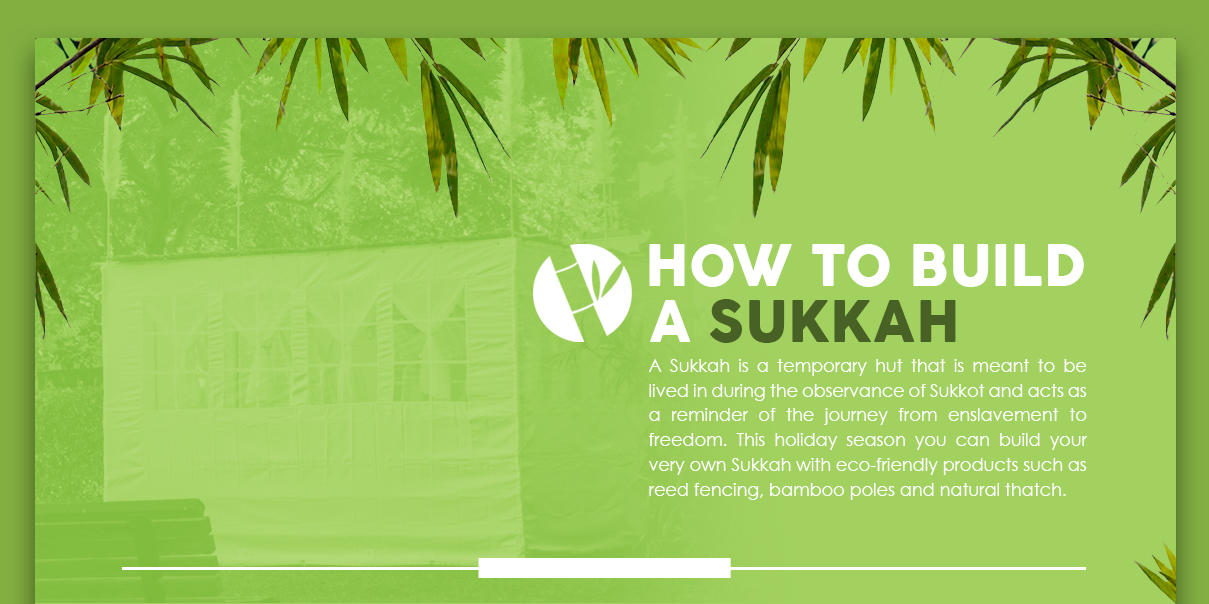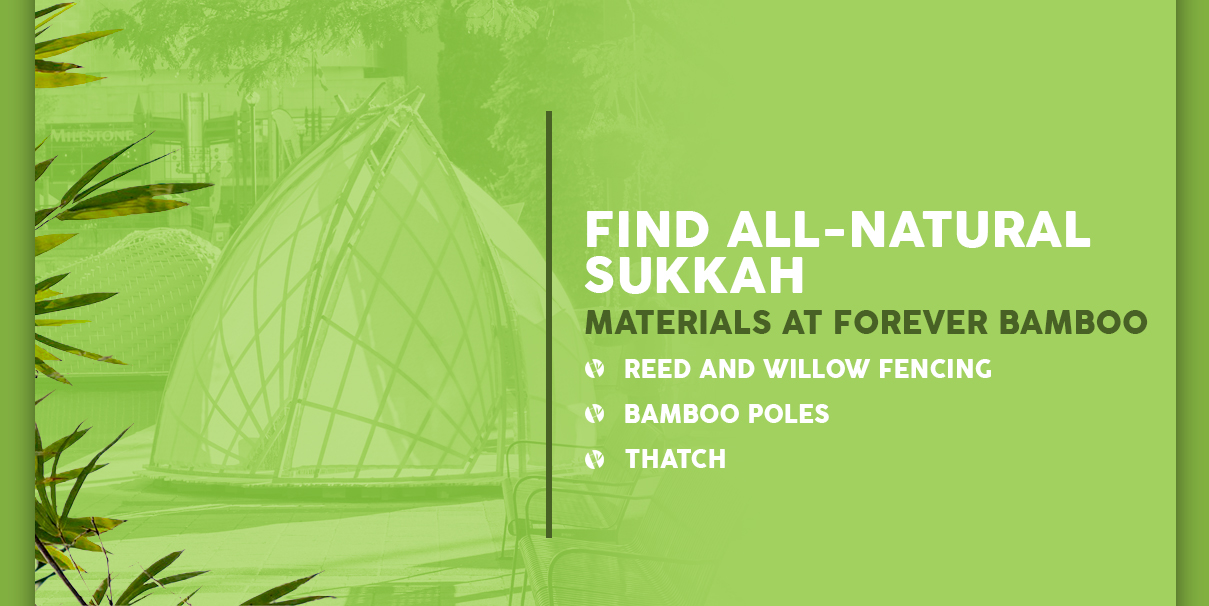As September and October approach, Jewish families around the world will be celebrating Sukkot, one of the three pilgrimage holidays that mark the end of the summer harvest. This is a time to remember ancestral roots, reaffirm faith and experience simple living to celebrate life.
As the root of Sukkot, Sukkah structures — or natural huts with shade-providing roofs — are crucial to the observance of this holy time. A Sukkah is meant to be lived in during the observance of Sukkot and acts as a reminder of the journey from enslavement to freedom. Learn how to build a Sukkah below, along with other information about Sukkot.
Jump To Sections:
- What Is Sukkot?
- How Sukkot Is Celebrated: A Holiday of Journeys
- Practices of Sukkot
- What Is a Sukkah Building?
- Significance of Building Your Own Sukkah
- Requirements for Building a Sukkah
- Necessary Materials for Building a Sukkah From Scratch
- How to Build a Kosher Sukkah
- Sukkah Rules — How to Use a Sukkah
- Find All-Natural Sukkah Materials at Forever Bamboo
This holiday season, you can build your very own Sukkah with eco-friendly products such as reed fencing, bamboo poles and natural thatch from Forever Bamboo. If you’re looking for simple Sukkah plans, Sukkah requirements and information on the meaning of the holiday itself, here’s everything you need to help you build your Sukkah and make the most of this Sukkot.
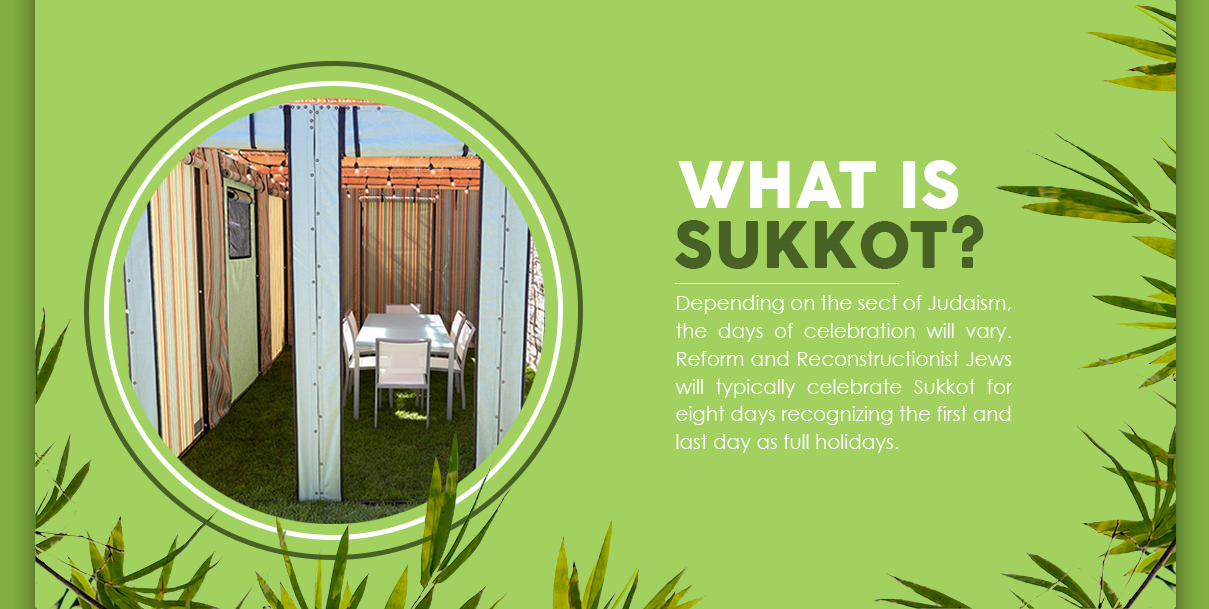
What Is Sukkot?
The holiday of Sukkot commemorates the Jewish people’s journey from oppression in Egypt as they sought freedom. Depending on the sect of Judaism, the days of celebration will vary. Reform and Reconstructionist Jews will typically celebrate Sukkot for eight days, recognizing the first and last day as full holidays. Conservative and Orthodox Jews celebrate Sukkot for nine days, recognizing the first two and last two days of celebration. The five or six remaining days are referred to as “Chol Hamoed,” or the “weekdays of the festival.”
Sukkot takes place on the 15th day of Tishrei, the seventh month in the Jewish calendar. This is five days after Yom Kippur. Typically, this falls somewhere from late September to late October. In 2020, Jewish families will celebrate Sukkot from roughly October 2 to October 9.
Sukkot is a reminder of the Israelites’ difficult 40-year journey through the desert and the miracle of how they were instructed to build shelter and provided food during that time. After long days of farming, the Israelites would build huts to live in to alleviate their workload during the fall harvest.
The symbolism of an open Sukkah is to invite and welcome kindness and support from those around us, not block it out with concrete or steel walls. Materials such as bamboo and reed serve as excellent building materials when it comes to constructing a homemade Sukkah.
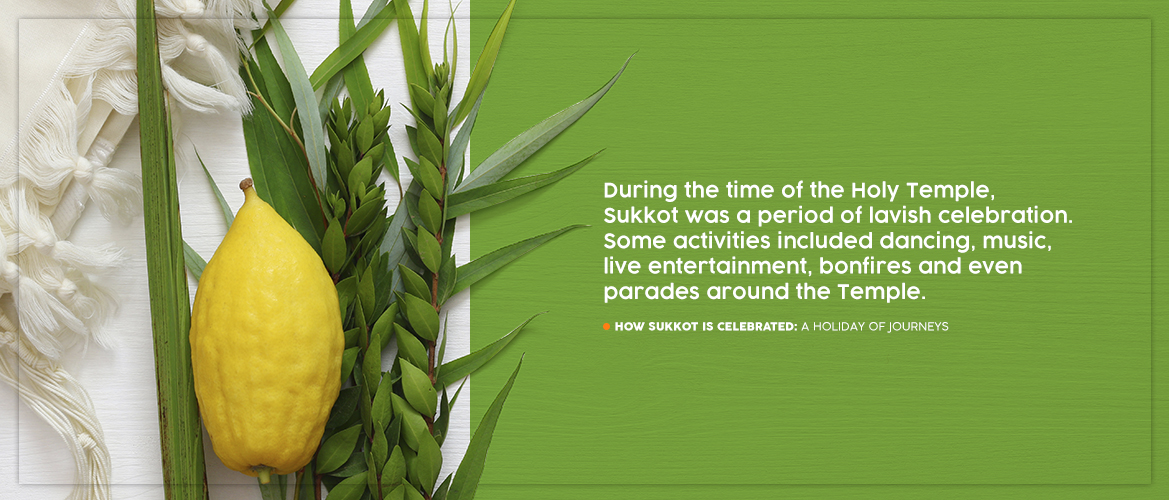
How Sukkot Is Celebrated: A Holiday of Journeys
During the time of the Holy Temple, Sukkot was a period of lavish celebration. Some activities included dancing, music, live entertainment, bonfires and even parades around the Temple. The Jewish people would also pray for protection and rain to ensure a good harvest year.
Today, it is common to see a Sukkah decorated with fruit, artwork, photos of family and friends and even cots to sleep on during the nighttime. It is also customary to set up tables and chairs to welcome guests and share food with. The gathering of friends and family far and near exemplifies the commitment to positive change and a sign of gratitude for the love and support of everyone present.
Sukkot is also a time to recognize that growth is not a stand-alone journey. Those who celebrate gather with others in the partial shelter of the Sukkah, which itself may represent the clouds that shielded ancestors from the desert sun or the tent dwellings they used in their 40-year journey. As for how to celebrate Sukkot, that could vary.
Practices of Sukkot
While modern practices differ from strict traditional practices when it comes to Sukkot, these are the general traditional practices many Jewish people follow during the holiday. Depending on your level of obedience, traditions may differ. Your practices may follow this timeline:
- The first days may include lighting candles and enjoying festive meals. Work is forbidden on these days.
- The days between involve dwelling in the Sukkah.
- The final days and following days are considered a separate holiday.
Each day of Sukkot, excluding Shabbat, four symbols representing the harvest are used in prayer. The four symbols — also called the Four Kinds — include the etrog (citron), lulav (palm leaves), hadasim (myrtle branches) and aravot (willow branches). All four symbols are held and shaken in the direction of North, South, East, West, up and down to symbolize the presence of God in all directions.
What Is a Sukkah Building?
A Sukkah is a hut that is covered in natural materials and built outside. It features at least three walls and is the location for eating all or most meals during Sukkot. Many even spend their nights in the Sukkah, effectively using it as their home throughout Sukkot.
Significance of Building Your Own Sukkah
While you can purchase a pre-built or prefab Sukkah kit to incorporate into your Sukkot practices, many find that it is more wholesome, symbolic and spiritual to construct their own. With that bit of effort, they get to dwell in a space they’ve devised themselves. They can then have better control over the materials and establish a tradition with family and friends of constructing their own Sukkah every Sukkot.
It’s a moderately easy process, but if you’re planning to build a Sukkah, there are a few requirements you’ll have to follow to prevent flimsiness, keep the area covered and stay in keeping with the sect of Judaism you adhere to.
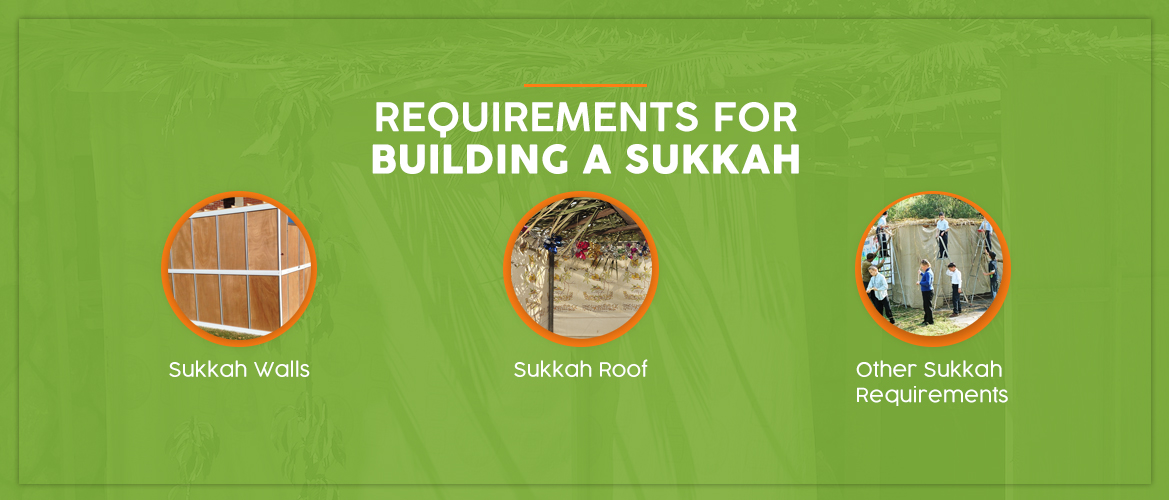
Requirements for Building a Sukkah
Regarding location, you should construct your Sukkah outdoors in a place easily accessible from your residence. Locations like your patio, balcony, backyard, roof, courtyard or lawn are all acceptable — just make sure your Sukkah is under the open sky and nothing interferes with this. You shouldn’t allow any overhanging structure — like tree branches, roofs or canopies — to come between the open sky and your Sukkah.
These are the modern requirements of a kosher Sukkah, but the strictness of the rules you follow for construction will depend on your rabbi’s instructions and your sect of Judaism. If you are looking for more detailed Sukkah building plans, here are the traditional requirements:
Sukkah Walls
To meet kosher requirements, a Sukkah must follow these dimensions and specifications:
- At least three walls, which includes a minimum of two full walls and a third wall no smaller than 3.2 inches wide.
- For best practice, make your Sukkah with four full walls.
- Walls at least 32 inches high.
- A height no taller than 30 feet as a whole structure.
- For length and width, your Sukkah design cannot be any smaller than 22.4 by 22.4 inches.
- There is no limit on how long and wide your Sukkah may be to accommodate your family or provide more comfort.
You can construct walls of any material sturdy enough to hold up in a regular wind, including wood, fiberglass, metal, canvas, siding, sheets and so on. You’ll want a sturdy structure for the walls, especially if you are building a longer and wider Sukkah to accommodate your family.
Sukkah Roof
The roof, also referred to as the s’chach, will need to be covered with branches and leaves, allowing for enough space to view stars during the nighttime. The branches and leaves act as a reminder of the harvest.
The Sukkah’s roof must be composed of all-natural, unprocessed, organic plant material like leafy tree overgrowth, palm fronds, bamboo, evergreen, corn stalks or unfinished lumber. The purpose of your s’chach is to provide shade, so it must cover a large enough space that more shade than sun will be on the floor of the Sukkah during the brightest point of midday.
You must also spread the s’chach evenly across the entire Sukkah, leaving no gap larger than 9.6 inches. Traditionally, anything you use to support or fasten the s’chach must be composed only of materials suitable for being used as roofing material themselves.
For example, you may use strips of unfinished wood to support the s’chach resting on your Sukkah walls, but you cannot tie or fasten the material with wire or metal. However, not all Judaism sects follow this rule about the material being kosher. Some rabbis will argue that the bamboo must be free and clear of any treatment, as it must be 100% natural. Others are not as strict. We suggest contacting your local rabbi or Synagogue to see how to build a kosher Sukkah, as it will differ for everyone.
Other Sukkah Requirements
In addition to those basic rules for building a Sukkah, there are a few more qualities to consider. Here are some traditional rules to keep in mind when drawing up your Sukkah building plans for a traditional structure — although these rules can vary depending on your sect:
- Reconstructing every year: To meet the traditional mitzvah — or commandment — requirements for Sukkot, you should rebuild your Sukkah every year. This requirement only applies to the s’chach or roof covering, however, because this part is what makes the structure a Sukkah. Therefore, you may leave the walls standing all year before Sukkot and leave them for use next year after the festival ends. As long as you take down the s’chach and construct a new roof to replace it each year, that makes the Sukkah new.
- Building order: If you are following traditional requirements, you must erect the walls first and then put the s’chach covering in place, as the placing of the s’chach makes your Sukkah a shelter. Again, not all sects follow these strict rules, so consult with your rabbi to see what is appropriate.
- Wall construction: While four solid walls are the preferred design for a Sukkot shelter, incomplete Sukkah walls are acceptable in certain circumstances. If there’s a gap between the bottom of the walls and the ground, it cannot be larger than 9.6 inches. Also, the walls may contain gaps, as long as the gaps are no wider than 9.6 inches.
- Roof height: As long as the walls are at least 32 inches in height, the roof can be higher — as long as it does not exceed 30 feet and the walls are beneath it.
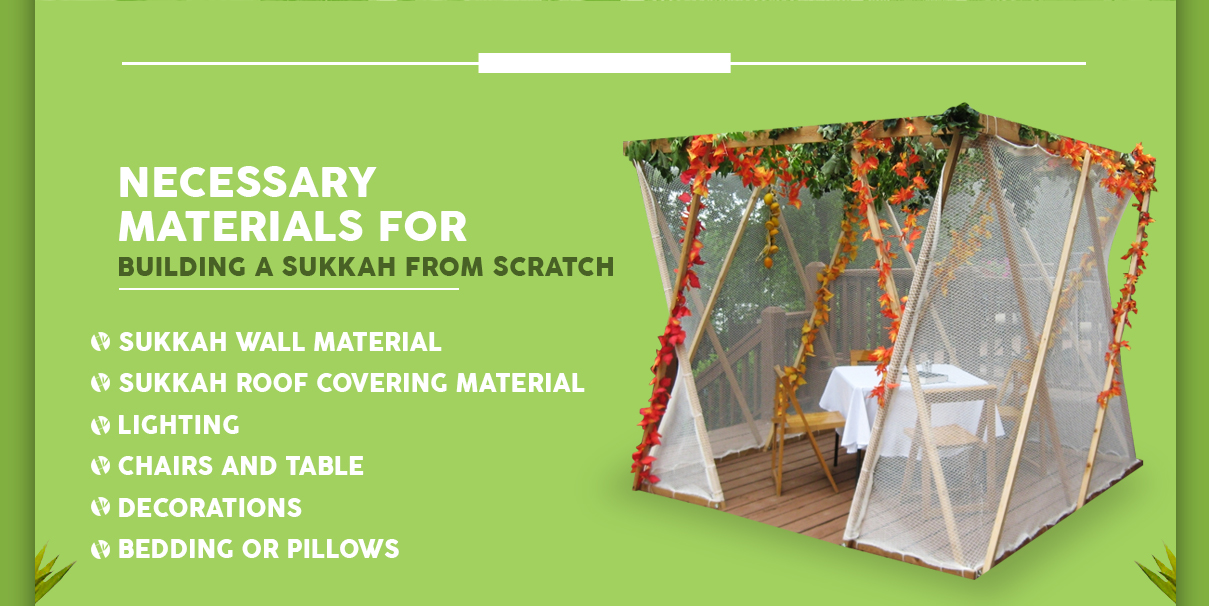
Necessary Materials for Building a Sukkah From Scratch
With the significance of building your own Sukkah, you may be eager to create your own. Before you begin building your Sukkah, consider where you will build it. Measure how much space you have and evaluate how much space you’ll need, keeping it in line with requirements. The amount of space you have and the size of your family will influence the size of your Sukkah as well.
From there, you can create a building plan and have a better idea of what materials you’ll need to create your Sukkah from scratch. Note these DIY materials to build a Sukkah that you may need:
1. Sukkah Wall Material
Your Sukkah walls can be any material, so choose whatever you have on hand or whatever you think will make the most sturdy construction. You can use sheets, canvas, wood, metal, fiberglass or pre-existing wall materials — as long as it resists wind and can withstand the weight of your s’chach in structure, it’s acceptable. Make sure you have enough material for three to four walls.
2. Sukkah Roof Covering Material
For your roof covering, you need organic, unfinished, unprocessed vegetable matter like Mexican palm thatch, bamboo poles, evergreen branches, unfinished lumber strips, corn stalks, leafy materials and so on. Any material you use must be detached from its growth source, meaning any live plants or branches still attached to a tree are unacceptable.
You can use s’chach mats made of straw, bamboo or other vegetable matter. Traditionally, you should use them only if they are previously unused and made for the sole purpose of serving as roof coverings for your Sukkah, but consult with your rabbi for roofing practices in your sect. In addition to natural, fresh roofing material, you may need unfinished wood beams to create a framework for laying down your s’chach, especially in a wider or longer structure.
3. Lighting
If you choose to have lighting within your Sukkah to use for reading or better visibility at night, make sure you build your Sukkah close to an outlet or power source and purchase an electrical cord and rain-protected lightbulbs.
4. Chairs and a Table
Since you’ll be eating meals in your Sukkah, plan to set up a dining area for comfort and celebration. Include a large enough table and enough chairs to accommodate your family and your guests for the duration of Sukkot.
5. Decorations
It’s customary for Jewish families to set up religious or harvest-themed decorations to adorn their Sukkah and make the space feel more like home. Your community may provide you with colorful themed posters to hang on your walls, or you can hang fresh fruits, plants or other decorations from your s’chach beams according to your tastes.
6. Bedding or Pillows
While it’s not customary, some people do choose to sleep in their Sukkah to embrace the spirit of the dwelling. If you decide to spend your nights in the Sukkah, make sure to include some blankets, mats or pillows to make yourself comfortable while you rest.
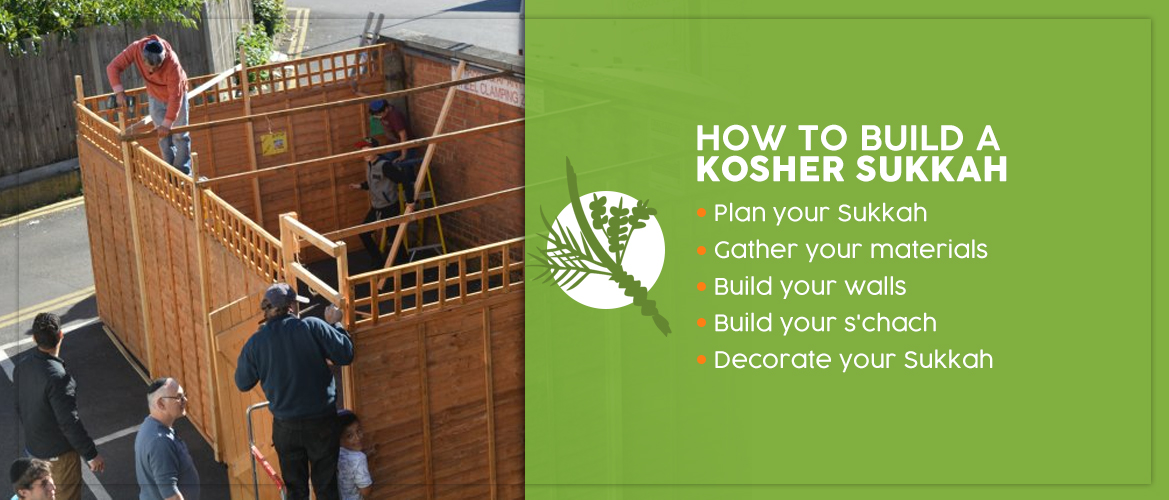
How to Build a Kosher Sukkah
With the basics down and your bases covered in terms of materials and dimensional requirements, it’s time to start building your Sukkah. Here are the steps you’ll need to follow to learn how to build a Sukkah:
- Plan your Sukkah: Before any building, make sure to plan out your Sukkah design according to the requirements and dimensions mentioned above for kosher standards. Draw your design with notes for your size specifications and the exact measurements you’ll need to make. Decide on the location for your Sukkah and plan sizing accordingly.
- Gather your materials: With your Sukkah plans complete, collect all the materials you’ll need according to the previously mentioned Sukkah construction rules.
- Build your walls: Start the building process by constructing your walls from whichever material you’ve chosen. If you’re using soft materials like canvas or sheets, stretch them around metal or wooden poles to secure them. Otherwise, stack your cinderblocks, put together your wood planks or cut your material to construct walls of the appropriate size, making sure to pay special attention to keeping the right measurements. Put your walls together to create your standing Sukkah structure.
- Build your s’chach: After finishing your walls, lay down your unfinished strips of supporting wood for your framework. Build up the layers of your s’chach with your organic vegetable materials, paying close attention to measurements. Make sure to leave some gaps for the stars, but not too many or ones that are too large. When your roof is complete, place it on top of your walls to complete your Sukkah.
- Decorate your Sukkah: If you plan to decorate, bring in the additional materials you’ll need to make your Sukkah a comfortable dwelling and set up your tables, chairs and other items to your preferences. Your Sukkah is now ready for Sukkot.
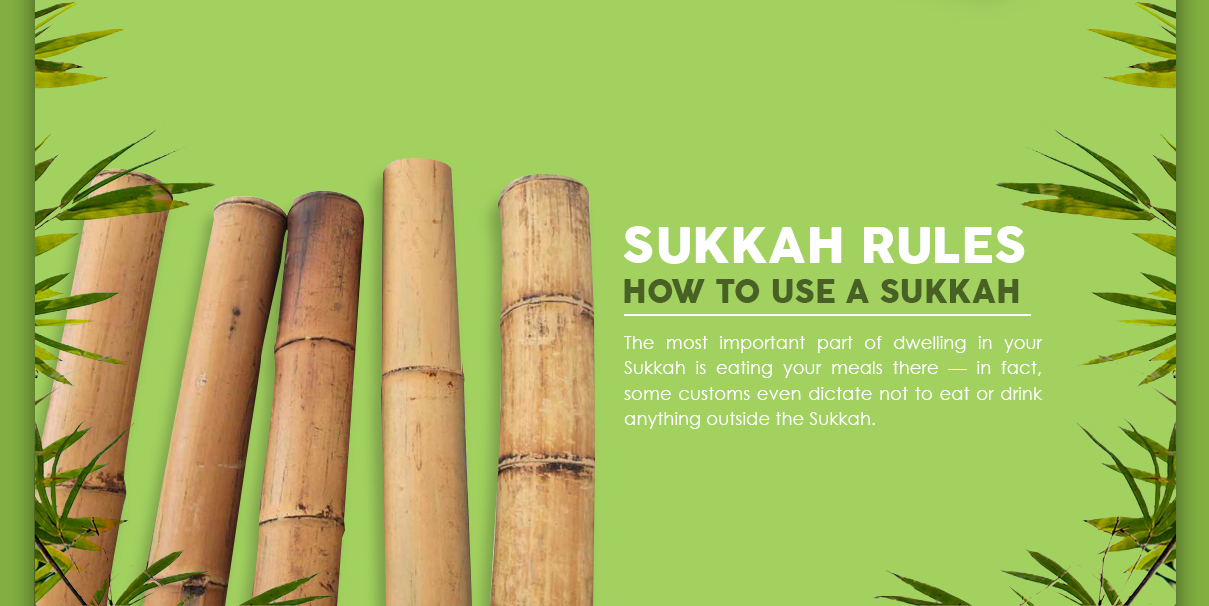
Sukkah Rules — How to Use a Sukkah
When Sukkot begins, it’s time to treat it as your dwelling for the week. With your Sukkah constructed properly, you should continue to follow Sukkah rules to observe the holiday in a respectful and beneficial manner. The most important part of dwelling in your Sukkah is eating your meals there — in fact, some customs even dictate not to eat or drink anything outside the Sukkah. Your goal is to spend as much time as possible in the Sukkah, going about your normal daily activities, socializing, praying and contemplating.
Families usually say blessings before eating meals in the Sukkah. You don’t necessarily need to sleep in your Sukkah, but you may if you prefer. Many make the decision based on personal preference and the climate where they live. While it’s certainly important to observe the holiday and contemplate the symbolism of the Sukkah, tradition doesn’t obligate observers to continue to sit in especially uncomfortable situations. For example, if a rainstorm comes through, you may leave the Sukkah and return later.
Find All-Natural Sukkah Materials at Forever Bamboo
When you’re looking for the right materials to build your Sukkah from scratch, Forever Bamboo has the all-natural, unprocessed materials you need as well as a friendly, knowledgeable team ready to help you Monday through Friday. Choose from the following materials for your Sukkah roofing and wall materials:
- Reed and willow fencing: As an affordable and all-natural alternative to heavier wall materials for your Sukkah, our reed and willow fencing options are subtle and suitable for building your walls tastefully.
- Bamboo poles: Also natural and high-quality options, our bamboo poles make a sturdy wall material for your Sukkah. You may also use them as required for creating a structure for your roof materials.
- Thatch: Eco-friendly and available in Mexican Palm, Tahitian Palm and African Cape Reed thatch, our natural thatch products are perfect for constructing your Sukkah’s roof.
With Forever Bamboo, you can order a sample box to take a look at our materials before you buy. If you place your order within 45 days of purchasing your samples, you’ll receive $25 off. This makes your sample box FREE!
As the nation’s number one outdoor living provider, we promise the highest-quality natural materials you can find — shipped right to your door for your Sukkah building plans. Explore everything we have to offer and request a quote or contact us online today.

